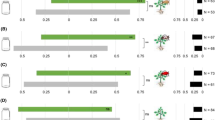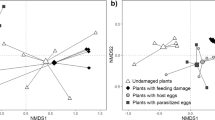Abstract
The responses of femaleAphidius ervi to odors from a host food plant (Vicia faba), host aphids (Acyrthosiphon pisum), nonhost aphids (Aphis fabae), and aphid-plant complexes were investigated in a specially designed wind tunnel and a Y-tube olfactometer. In single-target (no-choice) and two-target (dual-choice) experiments, plant volatiles played a crucial role in the host foraging behavior ofA. ervi. The odor from theA. pisum-plant complex elicited the strongest responses byA. ervi females, followed by the odor from plants previously damaged by the feeding ofA. pisum. There was a significantly weaker response to odor fromA. pisum in the absence of the plant and to undamaged plants. Similarly, mechanically damaged plants and plants infested with the nonhost aphidA. fabae did not elicit strong responses. A plant that had been damaged byA. pisum and subsequently washed with distilled water was as attractive as an unwashed, previously infested plant.Aphidius ervi probably overcomes the reliability-detectability problem by selectively responding to herbivore-induced, volatile, semiochemical cues emitted by the first trophic level and by distinguishing between the volatiles induced by host and nonhost aphids.
Similar content being viewed by others
References
Bouchard, Y., andCloutier, C. 1984. Honeydew as a source of host-searching kairomones for the aphid parasitoidAphidius nigripes (Hymenoptera: Aphidiidae).Can. J. Zool. 62:1513–1520.
Dicke, M. 1988. Infochemicals in tritrophic interactions. Origin and function in a system consisting of predatory mites, phytophagous insects and their host plants. PhD thesis. Wageningen Agricultural University. 235 pp.
Dicke, M. 1994. Local and systemic production of volatile herbivore-induced terpenoids: Their role in plant-carnivore mutualism.J. Plant Physiol. 143:465–472.
Dicke, M., van Beek, T. A., Posthumus, M. A., Ben Dom, N., van Bokhoven, H., andDe Groot, A. E. 1990. Isolation and identification of a volatile kairomone that effects acarine predator-prey interaction. Involvement of host plant in its production.J. Chem. Ecol. 16:381–396.
Ding, D., Swedenborg, P. D., andJones, R. L. 1989. Plant odor preferences and learning inMacrocentrus grandii (Hymenoptera: Braconidae), a larval parasitoid of the European corn borerOstrinia nubilalis (Lepidoptera: Pyralidae).J. Kans. Entomol. Soc. 62:164–176.
Eller, F. J., Tumlinson, J. H., andLewis, W. J. 1988a. Beneficial arthropod behavior mediated by airborne semiochemicals. VII. Source of volatiles mediating the host location flight behavior ofMicroplitis croceipes (Cresson) (Hymenoptera: Braconidae) a parasitoid ofHeliothis zea (Boddie) (Lepidoptera: Noctuidae).Environ. Entomol. 17:745–753.
Eller, F. J., Tumlinson, J. H., andLewis, W. J. 1988b. Beneficial arthropod behavior mediated by airborne semiochemicals. II. Olfactometric studies of host location by the parasitoidMicroplitis croceipes (Cresson) (Hymenoptera: Braconidae).J. Chem. Ecol. 14:425–434.
Elzen, G. W., Williams, H. J., andVinson, S. B. 1993. Response by the parasitoidCampoletis sonorensis (Hymenoptera: Ichneumonidae) to chemicals (synomone) in plants: Implications for host habitat location.Environ. Entomol. 12:1873–1877.
Grasswitz, T. R., andPainf, T. D. 1993. Effect of experience on in-flight orientation to hostassociated cues in the generalist parasitoidLysiphlebus testaceipes.Entomol. Exp. Appl. 68:219–229.
Guerrieri, E., Pennacchio, F., andTremblay, E. 1993. Flight behaviour of the aphid parasitoidAphidius ervi (Hymenoptera: Braconidae) in response to plant and host volatiles.Eur. J. Entomol. 90:415–421.
Lewis, W. J., andMartin, W. R., Jr. 1990. Semiochemicals for use with parasitoids: Status and future.J. Chem. Ecol. 16:3067–3089.
Mattiacci, L., Dicke, M., andPosthumus, M. A. 1994. Induction of parasitoids attracting synomone in Brussels sprouts plants by feeding ofPieris brassicae larvae: Role of mechanical damage and herbivore elicitor.J. Chem. Ecol. 20:2229–2247.
McAuslane, H. J., Vinson, S. B., andWilliams, H. J. 1991. Stimuli influencing host microhabitat location in the parasitoidCampoletis sonorensis.Entomol. Exp. Appl. 38:267–277.
Michaud, J. P., andMackauer, M. 1995. The use of visual cues in host evaluation by aphidiid wasps.Entomol. Exp. Appl. 74:267–275.
Nottingham, S. F., Hardie, J., Dawson, G. W., Hick, A. J., Pickett, J. A., Wadhams, L. J., andWoodcock, C. M. 1991. Behavioural and electrophysiological responses of aphids to host and nonhost plant volatiles.J. Chem. Ecol. 17:1231–1242.
Powell, W., andZhang, Z. L. 1983. The reactions of two cereal aphid parasitoids,Aphidius uzbeckistanicus andA. ervi to host aphids and their food plants.Physiol. Entomol. 8:439–443.
Read, D. P., Feeny, P. P., andRoot, R. B. 1970. Habitat selection by the aphid parasiteDiaeretiella rapae (Hymenoptera: Braconidae) and hyperparasiteCharips brassicae (Hymenoptera: Cynipidae).Can. Entomol. 102:1567–1578.
Schuster, D. J., andStarks, K. J. 1974. Response ofLysiphlebus testaceipes in an olfactometer to a host and a non-host insect and to plants.Environ. Entomol. 3:1034–1035.
Sheehan, W., andShelton, A. M. 1989. The role of experience in plant foraging by the aphid parasitoidDiaeretiella rapae (Hymenoptera: Aphidiidae).J. Insect Behav. 2:743–759.
Steinberg, S., Dicke, M., Vet, L. E. M., andWanningen, R. 1992. Response of the braconid parasitoidCotesia glomerata to volatile infochemicals: Effect of bioassay set-up, parasitoid age and experience and barometric flux.Entomol. Exp. Appl. 63:163–175.
Steinberg, S., Dicke, M., andVet, L. E. M. 1993. Relative importance of infochemicals from first and second trophic level in long-range host location by the larval parasitoidCotesia glomerata.J. Chem. Ecol. 19:47–59.
Takabayashi, J., Dicke, M., andPosthumus, M. A. 1991. Variation in composition of predatorattracting allelochemicals emitted by herbivore-infested plants: Relative influence of plant and herbivore.Chemoecology 2:1–6.
Takabayashi, J., Dicke, M., Takahashi, S., Posthumus, M. A., andvan Beek, T. A. 1994. Leaf age affects composition of herbivore-induced synomones and attraction of predatory mites.J. Chem. Ecol. 20:373–386.
Tumlinson, J. H., Turlings, T. C. J., andLewis, W. J. 1992. The semiochemical complexes that mediate insect parasitoid foraging.Agric. Zool. Rev. 5:221–252.
Tumlinson, J. H., Lewis, W. J., andVet, L. E. M. 1993. How parasitic wasps find their hosts.Sci. Am. 268:100–106.
Turlings, T. C. J., Tumlinson, J. H., Eller, F. J., andLewis, W. J. 1990. Exploitation of herbivore-induced plant odors by host-seeking parasitic wasps.Science 250:1251–1253.
Turlings, T. C. J., Tumlinson, J. H., Eller, F. J., andLewis, W. J. 1991. Larval-damaged plants: Source of volatile synomones that guide the parasitoidCotesia marginiventris to the microhabitat of its hosts.Entomol. Exp. Appl. 58:75–82.
Vet, L. E. M., andDicke, M. 1992. Ecology of infochemical use by natural enemies in a tritrophic context.Annu. Rev. Entomol. 37:141–172.
Vinson, S. B. 1985. The behaviour of parasitoids. pp. 417–489,in G. A. Kerkut and L. I. Gilbert (eds.). Comprehensive Insect Physiology Biochemistry and Pharmacology. Vol. 9. Pergamon Press, Oxford.
Visser, J. H. 1986. Host odor perception in phytophagous insects.Annu. Rev. Entomol. 31:121–144.
Visser, J. H., van Straten, S., andMaarse, H. 1979. Isolation and identification of volatiles in the foliage of potato,Solanum tuberosum, a host plant of the Colorado beetle,Leptinotarsa decemlineata.J. Chem. Ecol. 5:13–25.
Wackers, F. L. 1994. The effect of food deprivation on the innate visual and olfactory preferences in the parasitoidCotesia rubecula.J. Insect Physiol. 40:641–649.
Whitman, D. W., andEller, F. J. 1990. Parasitic wasps orient to green leaf volatiles.Chemoecology 1:69–75.
Wickremasinghe, M. G. V., andvan Emden, H. F. 1992. Reactions of adult female parasitoids, particularlyAphidius rhopalosiphi, to volatile cues from the host plants of their aphid prey.Physiol. Entomol. 17:297–304.
Author information
Authors and Affiliations
Rights and permissions
About this article
Cite this article
Du, Y.J., Poppy, G.M. & Powell, W. Relative importance of semiochemicals from first and second trophic levels in host foraging behavior ofAphidius ervi . J Chem Ecol 22, 1591–1605 (1996). https://doi.org/10.1007/BF02272400
Received:
Accepted:
Issue Date:
DOI: https://doi.org/10.1007/BF02272400




